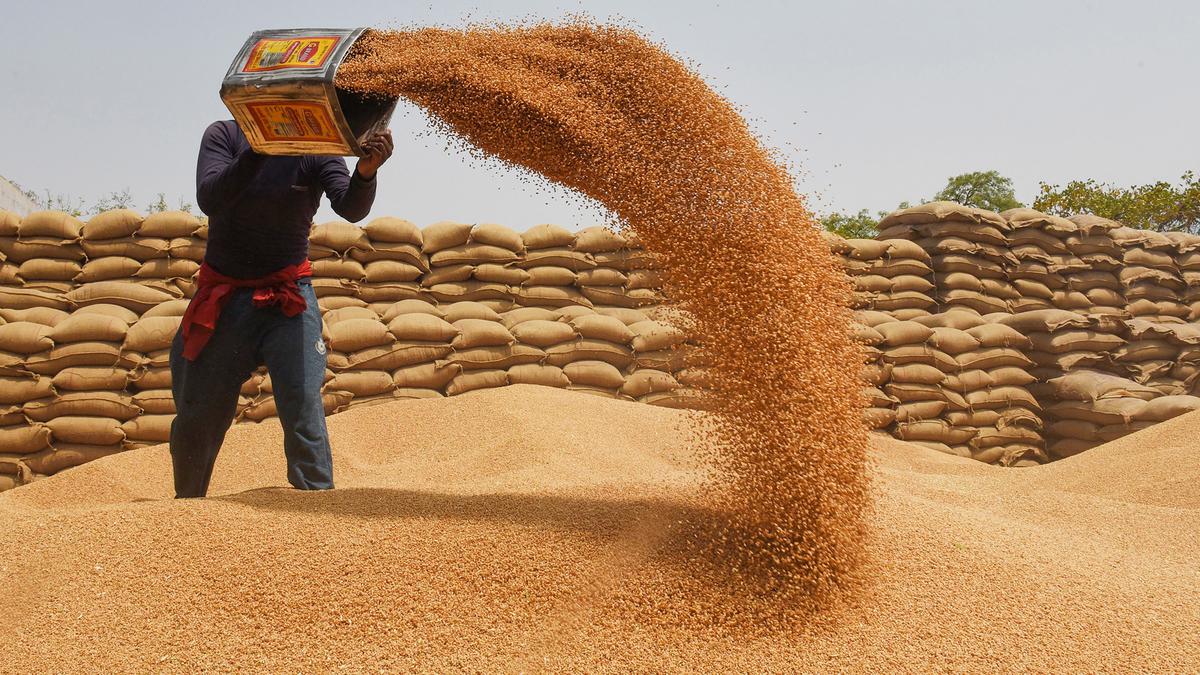Explained | The Centre-state tussle over the Open Market Sale Scheme

The story so far: States have been looking at alternative ways of procuring wheat and rice in the aftermath of the Food Corporation of India’s (FCI) quantity restrictions followed by the refusal to allow states to procure the two food grains through its Open Market Sale Scheme (OMSS). On Wednesday, June 28, the Congress government in Karnataka announced that being unable to procure enough rice in the market at a reasonable cost in time to meet the needs of its free good grain distribution scheme for BPL families- the Anna Bhagya scheme, it had decided to temporarily give cash to the beneficiaries in lieu of the promised five kg of free rice.
While the Centre has made it clear that the reason for first restricting supplies per bidder and eventually excluding states for the OMSS was to curb inflation and regulate supply, Opposition-ruled States such as Karnataka and Tamil Nadu have criticised the government for engaging in “politics” at the expense of marginalised beneficiaries of state welfare schemes.
What is the Open Market Sale Scheme (OMSS)?
Firstly, the procurement of food grains like wheat and paddy for the central pool happens in Rabi and Kharif marketing seasons by the FCI and State corporations according to procurement estimates finalised by the government of India before the seasons. These purchases happen as per the Minimum Support Price. From the central pool, the government has to set aside wheat and rice for the 80 crore beneficiaries of free foodgrains under the National Food Security Act (NFSA), maintain a buffer stock, and have a marketable surplus.
Under the Open Market Sale Scheme, the FCI from time to time sells surplus food grains from the central pool especially wheat and rice in the open market to traders, bulk consumers, retail chains and so on at pre-determined prices. The Corporation does this through e-auctions where open market bidders can buy specified quantities at the prices set at the start of a cycle and revised routinely. Usually, states are also allowed to procure food grains through the OMSS without participating in the auctions, for their needs beyond what they get from the central pool to distribute to NFSA beneficiaries.
The idea is to activate the OMSS during the lean season, the time between harvests, to improve and regulate domestic supply and availability of the two grains and bring down their prices in the open market; essentially making the scheme a measure to curb food grain inflation.
This year’s OMMS was operationalised by the FCI in the month of January. According to the latest press release of the Food Ministry, six weekly e-auctions of wheat had been conducted by FCI till March 15, 2023. “The total quantity of 33.7 LMT wheat was offloaded and the prices of Wheat came down by 19% due to this massive intervention in a span of 45 days,” noted the release.
The next e-auction for wheat under OMSS is due to start on June 28 and the bidding for rice will commence on July 5. The FCI has kept a base price of wheat at the same level at ₹2,150 per 100 kg, while that for rice has been set at ₹3,100 per quintal.
The sales have been fairly low during the last few years owing to harvests getting affected by weather conditions as well as lower surpluses when the government distributed additional free food grains under the Garib Kalyan Yojana in the pandemic years. The scheme started during the pandemic has now been merged under the NFSA.
How has the Centre revised the OMSS?
Recently, the Centre decided to restrict the quantity that a single bidder can purchase in a single bid under the OMSS. While the maximum quantity allowed earlier was 3,000 metric tonnes (MT) per bid for a buyer, it will now range from 10-100 metric tonnes (MT).
The rationale given for the same by the Corporation is that the quantities have been reduced this time “to accommodate more small and marginal buyers and to ensure wider reach of the scheme”. The body contends this move will allow the supplies to the general public immediately. The objective behind the move is also to curb retail prices as allowing smaller bids should ideally break monopolies of bulk buyers, allowing more competitive bids by small buyers.
Due to global supply chain shocks like the Russia-Ukraine conflict and hampered production at home, retail food inflation has risen sharply. In February this year, retail wheat inflation was up by 25.37% and only declined to 19.91% in March. As per official data, rice prices have increased by up to 10% in the last year at the mandi level, while by 8% in the last month.
Another reason for the move is to meet the FCI’s food security obligations. The Centre said that in recent years, production of agriculture crops was affected due to untimely rains, rise in temperature in the month of March and so on, making it incumbent upon the FCI to release its stocks “judicious manner under the OMSS (D)” so that the overall stock position is maintained at a comfortable level”.
Why has the FCI discontinued the sale of grains under OMSS to states?
First, the Centre had decided earlier this month to reduce the quantity a particular bidder can purchase under the OMSS, but on June 13, in a notification sent to the States on June, it stopped the sale of rice and wheat from the Central pool under the OMSS to state governments, also disallowing private bidders to sell their OMSS supplies to state governments.
The Centre has explained the discontinuation of OMMS grains to the states by giving the same rationale. “In order to ensure that the inflationary trends are kept under control while ensuring adequate stock levels in the Central pool it has been decided to exclude State governments from the ambit of OMSS(D), as per the revised Policy dated June 13, 2023,” the Centre said in a note.
Chairman and Managing Director of the FCI Ashok K.K. Meena, while announcing the FCI’s refusal to look at the request of states to allow more grains under OMSS, that the centre was already meeting its obligations to distribute grains to 80 crore marginalised beneficiaries under the NFSA, and also had an obligation to the 60 crore common consumers who are affected by retail prices.
Mr. Meena said the State governments would keep on demanding. “State governments are going to give the foodgrains to the same beneficiaries under the Pradhan Mantri Garib Kalyan Ann Yojana or they would be using the foodgrains for State schemes where identified beneficiaries are there.”
How have states reacted?
Besides what is distributed under the NFSA, many states, including those governed by Opposition parties, have their own welfare schemes to distribute subsidised or free grains to sections of the population.
In Karnataka, for instance, the Anna Bhagya scheme to give rice to marginalised families was a part of the recently-election Congress government’s state election promise. Karnataka Chief Minister Siddaramaiah and other leaders of the party have hit out at the Centre, accusing it of engaging in politics and conspiring to “fail” the State government’s poll guarantee by ensuring the State did not receive the required amount of rice to implement the scheme. It has also called the centre’s measure “anti-poor”.
Meanwhile, Tamil Nadu is trying to purchase 50,000 tonnes of rice from government agencies other than FCI. The state runs a universal PDS scheme. “We give rice to all ration card holders. We get 2,74,00 tonnes of rice from the Government of India. To manage the supplies, we were buying from OMSS at a rate of about ₹35 for a kilo of rice and then subsidising it. Now, the Union government has stopped the supply under OMSS. We have to find an alternative now,” a senior government functionary of Tamil Nadu told The Hindu.
The Kerala government on the other hand does not procedure grains under the OMSS but is planning to legal steps against the Centre’s overall food distribution policy. “Historically, Kerala does not produce sufficient foodgrains as the State is known for cultivating spices due to its tropical climate. The Centre’s assurance of ensuring adequate foodgrains for the State is not maintained now. We will take all possible steps against this,” a State Food Department official said recently.













